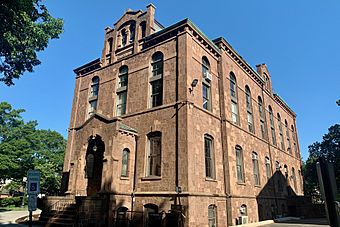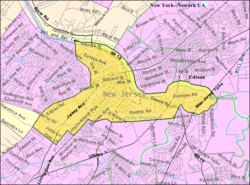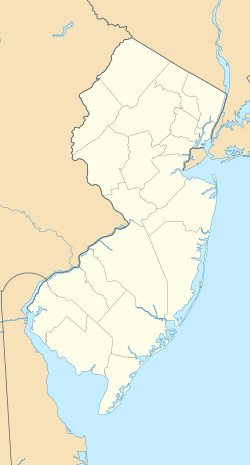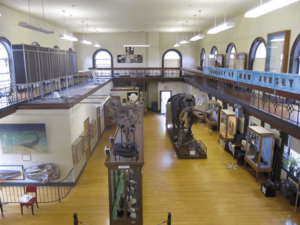Geology Hall, New Brunswick, New Jersey facts for kids
|
Geology Hall
|
|
|
U.S. Historic district
Contributing property |
|

Geology Hall in 2020
|
|
| Location | Rutgers University, New Brunswick, New Jersey |
|---|---|
| Part of | Queens Campus, Rutgers University (ID73001113) |
Quick facts for kids Significant dates |
|
| Designated CP | July 2, 1973 |
Geology Hall is an old and important building at Rutgers University in New Brunswick, New Jersey. It was built a long time ago, from 1871 to 1872. This building was made to hold science classes and the Rutgers Geology Museum. The museum started in 1872 thanks to George Hammell Cook, who was a geology professor at Rutgers. He used a collection of rocks and fossils that had been gathered since the 1830s.
Over time, as classes moved to other buildings, the museum grew bigger. By the mid-1900s, the museum took up the whole building. In 1973, Geology Hall became a registered historic place in New Jersey and on the National Register of Historic Places. It is part of a special historic area on the Queens Campus, which includes other old buildings like Old Queens and Kirkpatrick Chapel.
What is Geology Hall Like?
Location and Design
Geology Hall is located on the Queens Campus of Rutgers University. It stands between Van Nest Hall and Old Queens at 85 Somerset Street in New Brunswick, New Jersey. The building was designed by Henry Janeway Hardenbergh. Its style mixes old Gothic elements with classic shapes.
Hardenbergh first planned for the building to be made of brick. However, later on, it was decided to build Geology Hall using stone instead.
Inside the Building
When Geology Hall was finished in 1872, it had different areas for learning.
- The first floor had science laboratories.
- The upper floors were home to the geological museum.
- The basement had an armory for the college's military school.
In 1875, students from Princeton University took 25 muskets from this armory. This happened because Rutgers students had taken a cannon from Princeton earlier. In 1912, the basement was updated to create more space for classes.
History of Geology Hall and the Museum
How the Museum Started
The idea for the Rutgers University Geology Museum began in the 1830s. This was when a scientist named Lewis Caleb Beck worked at Rutgers. He was a chemist, doctor, and expert in minerals and plants. Beck collected many scientific samples, which were shown in Van Nest Hall.
After Beck passed away in 1853, Rutgers bought his collection. George Hammell Cook then became the new geology professor. In the early 1860s, Cook convinced the university to create a Scientific School. He also helped Rutgers become New Jersey's land-grant university. This meant it would receive special support for teaching science and agriculture.
Building the Hall
Rutgers received these special grants in 1864. However, growing its science programs and having fewer students caused money problems. In 1870, Rutgers' president, William Henry Campbell, and the university leaders started raising money. They wanted to support the Scientific School and celebrate Rutgers' 100th birthday.
They raised a lot of money, and some of it was used to build a new science building. This building was placed between Old Queens and Van Nest Hall.
Henry Janeway Hardenbergh was chosen to design the building. He was a descendant of Jacob Rutsen Hardenbergh, Rutgers' first president. Construction of Geology Hall began in April 1871. The first stone was laid by Theodore Fitz Randolph, who was the Governor of New Jersey at the time, on June 20, 1871. A time capsule was placed inside this stone. It held local newspapers and a history of Rutgers University. The building was finished in June 1872 and officially opened on June 18, 1872.
Growth of the Museum
The Geology Museum, which started in 1872, took up the upper floors of Geology Hall. In 1892, Albert Huntington Chester became the museum's first curator. He found the museum's collection disorganized. So, in 1893, he hired William S. Valiant to help organize everything. Valiant slowly took over Chester's duties. After Chester died in 1903, Valiant became the curator.
In 1896, Valiant wrote that the museum had almost 20,000 items, including a mastodon skeleton. By 1903, the collection had grown to 30,000 items. In 1926, Rutgers' Physics Department moved out of Geology Hall. This allowed the museum to expand and use the rest of the building. The museum's collection grew even more in 1940. It received a large collection of minerals from George Rowe, who had worked at a mine in Franklin, New Jersey.
Becoming a Historic Site
On January 29, 1973, Geology Hall and other 19th-century buildings on the Queens Campus were added to the New Jersey Register of Historic Places. Then, on July 2, 1973, it was also added to the National Register of Historic Places.
Starting in 1976, the museum changed its main goal. Instead of just research, it focused more on teaching and reaching out to the public. In 1977, the Geology Department moved to new offices on Rutgers' Busch Campus. This meant the Geology Museum became the only group using Geology Hall.
In 2013, there were rumors that the university might close the museum and put its exhibits away. However, many people, including former students and the public, wrote letters to save the museum. This convinced the university to keep the museum open and invest in it.






